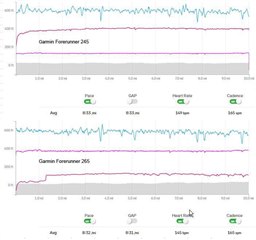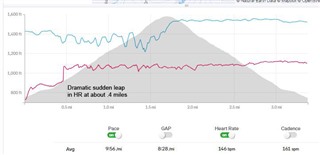


Three Visuals included.
1.The first is a 10 miles non stop flat run, on software 22.20. Note that about 10 minutes into the run the HR takes a sudden, unexplainable jump
2. 35 minutes on a stair climber. After the exercise ends I kept the watch recording and over the next 10 minutes the HR peaks twice to a level higher than at any time during the exercise and then drifts down in what looks like a repeatable pattern
3. A 5k run with a stepper hill. At about .4 miles in the HR does a straight up vertical jump from 126 bpm to 150 bpm!
The above is indisputable, below are my opinions and represent my experiences with the watch.
I can't say if these problems affect all users or just a subset. I can say for me the FR 265's Elevate Gen 4 Optical HR sensor is a real disappointment (compared to the FR 245 Elevate Gen 3 Optical HR sensor). To the point of; Garmin, I love the user interface and some of the features of the FR265 but fix the optical HR or just give me my money back.
OR - recall the watches with the Elevate 4 sensor, replace with the Elevate 3 sensor and the software to support the Elevate 3. OK, that's pie in the Sky, the user can't replace the battery in the watch, the optical HR sensor isn't going to be replaced.
OR Replace my watch with an equivalent that actually works! A LOT of the metrics I care about are based off of the HR readings. If the HR readings are bunk, then obviously the metrics follow suite. Again, my opinion but if the optical HR doesn't work reasonably (at least as well as it did in the FR245) then the watch does not meet the advertised standards for it's intended use.
I can live with the HR missing rapid peaks or having to install the newly released software twice because after the first install the watch forgot it had an HR sensor or even the random breakage of some features after a software "upgrade" as long as the core functions continue to work (or are fixed); I can't live with the core function of the HR not working reasonably.


